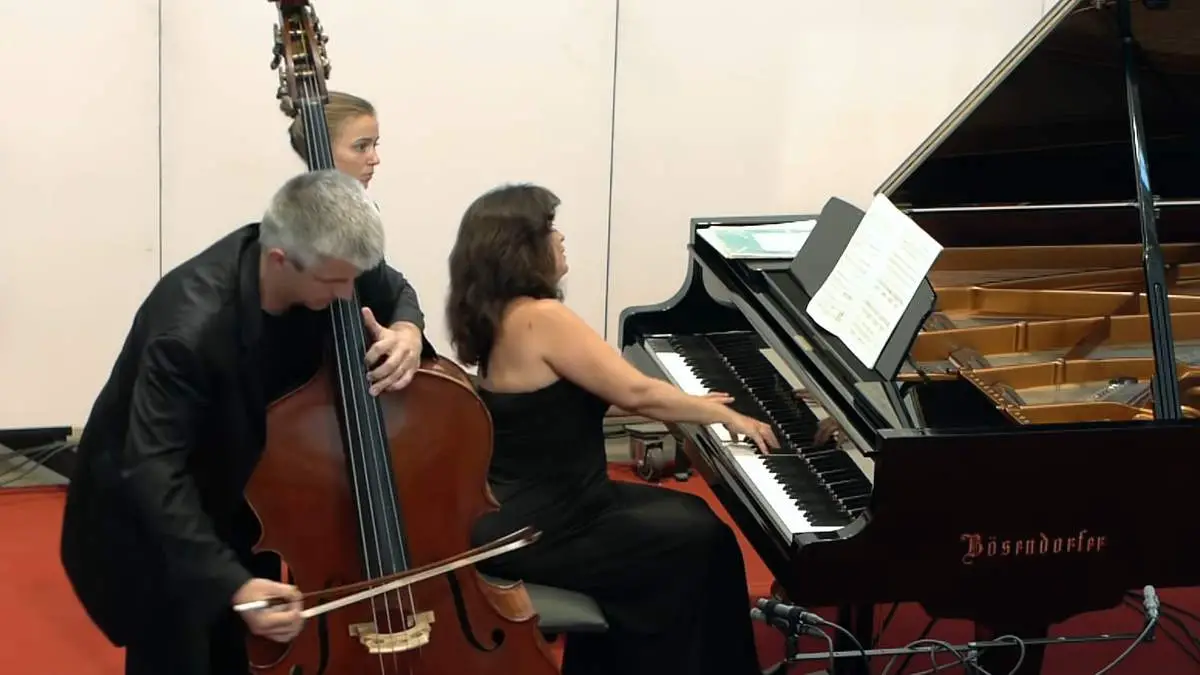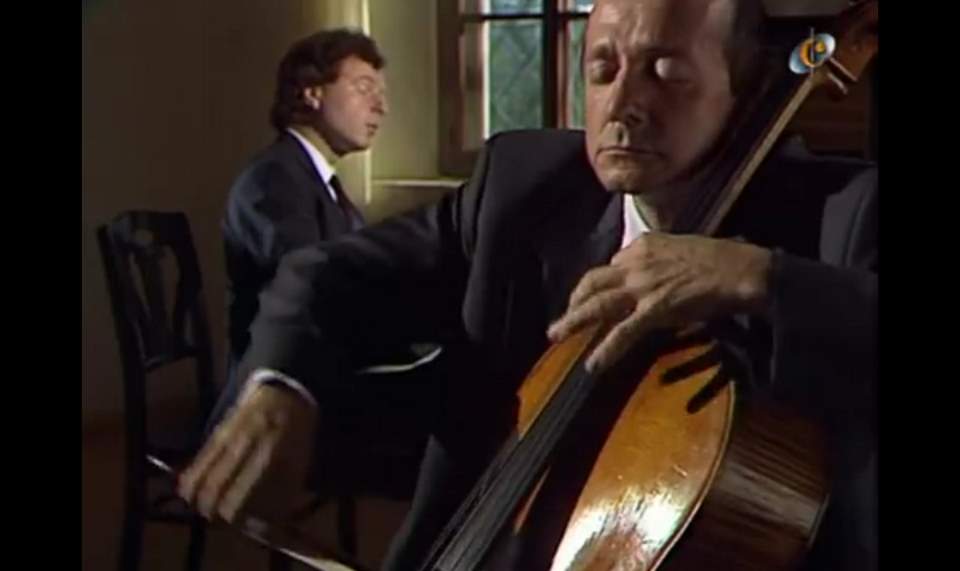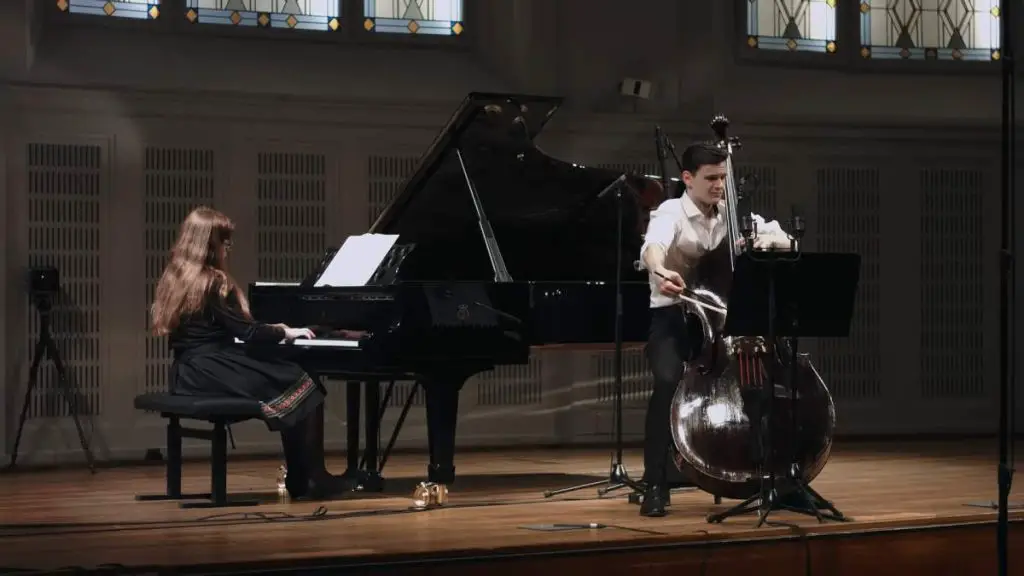Božo Paradžik (double bass) and Mira Wollmann (piano) perform Franz Schubert’s Sonata in A minor for Arpeggione and Piano, D. 821, also known as the “Arpeggione Sonata”. The sonata is originally written for arpeggione, a six-stringed musical instrument, fretted and tuned like a guitar, but bowed like a cello, and thus similar to the bass viola da gamba. Here, Paradžik performs it on double bass. This version for the double bass remains nearly throughout the piece one octave lower than the arpeggione’s part in the urtext, otherwise, it is performed according to the urtext. This performance was recorded at the Jesuit church of Sion, Switzerland, on July 15, 2013.
Franz Schubert’s Arpeggione Sonata
The Arpeggione Sonata, officially titled Sonata in A minor for Arpeggione and Piano, D. 821, is a piece composed by Franz Schubert in Vienna in November 1824. This composition is unique because it was written for the arpeggione, an instrument that was invented only a few years prior to the composition of the sonata. The arpeggione is a bowed string instrument with frets, somewhat akin to a hybrid between a guitar and a cello, invented by the Viennese guitar maker Johann Georg Stauffer in either 1823 or 1824. Despite its initial popularity, the arpeggione fell into obscurity, leading to the sonata being adapted and played primarily on the viola, cello, and even double bass, with the piano part remaining unchanged.
The historical context of the Arpeggione Sonata is fascinating, not just because of the instrument for which it was composed, but also because of its place in Schubert’s life. Schubert, known for his lieder (German art songs for voice and piano), chamber music, and symphonic works, was prolific in the year 1824, creating not only the Arpeggione Sonata but also other significant works. The sonata itself was not published until 1871, long after Schubert’s death in 1828, which partly explains why it was not widely recognized immediately.
The sonata’s music is emblematic of Schubert’s lyrical style, with beautiful melodies and emotional depth. Its composition for the arpeggione, an instrument capable of both guitar-like plucking and cello-like bowing, gives it a unique sound and texture, although modern performances adapt these characteristics to the interpreting instrument. The piece showcases Schubert’s masterful ability to write music that is technically demanding yet expressive, embodying the Romantic era’s characteristics of emotion and individuality.
Despite the arpeggione’s decline in popularity, the Sonata in A minor has endured as a beloved piece in the classical music repertoire, celebrated for its lyrical beauty and the emotional depth of its composition. Its adaptability to other instruments like cello, viola, or contrbass has contributed to its lasting legacy, allowing musicians and audiences to continue experiencing Schubert’s genius. The Arpeggione Sonata stands as a testament to Schubert’s ability to create enduring music, even for an instrument that would soon be forgotten. Its place in classical music history is secure, not only as a curiosity for its original instrumentation but also as a work of profound musical expression.
Movements
1. Allegro moderato
The first movement of Schubert’s Arpeggione Sonata, marked “Allegro moderato,” sets the stage for a sonata that is both rich in melodic beauty and deep in emotional expression. It begins with an inviting melody that immediately captures the listener’s attention, characterized by its warmth and lyricism. This movement is a fine example of Schubert’s ability to blend classical form with his unique sense of melody and harmony, creating music that is both accessible and profoundly moving.
In the “Allegro moderato,” Schubert utilizes the sonata form, a structure common in the classical period, consisting of an exposition, development, and recapitulation. However, what makes Schubert’s approach stand out is his ability to infuse this traditional form with a sense of freshness and emotional depth. The exposition introduces two main themes: the first is lyrical and expressive, showcasing the solo instrument’s melodic capabilities; the second theme provides contrast, often with a change in mood and tonality, adding complexity and richness to the musical texture.
The development section explores these themes further, taking the listener on an emotional journey through variations in harmony, dynamics, and texture. Schubert’s skill in developing these themes demonstrates his mastery of the form and his ability to convey a wide range of emotions within a single movement. This section often ventures into minor keys, adding a sense of tension and longing before leading back to the recapitulation.
The recapitulation brings back the themes from the exposition, often with subtle variations that reflect the journey undertaken in the development. This return to the familiar material provides a sense of closure and resolution, yet Schubert’s nuanced treatment ensures that the recapitulation feels earned, offering new insights into the themes.
Throughout the movement, the interplay between the piano and the solo instrument is of paramount importance. Schubert crafts a dialogue between the two, with the piano providing a harmonic and rhythmic foundation that complements and enhances the solo line. This partnership creates a rich, textured musical landscape, allowing for moments of intimate conversation as well as powerful, unified expressions.
The “Allegro moderato” is not just an opening movement; it is a statement of intent, showcasing Schubert’s lyrical gifts, his emotional depth, and his ability to create music that speaks directly to the human experience. It sets the tone for the sonata as a whole, inviting listeners into a world of beauty, longing, and introspection.
2. Adagio
The second movement of Schubert’s Arpeggione Sonata, marked “Adagio,” is a testament to the composer’s unparalleled ability to craft music of profound depth and beauty. This movement is a poignant, lyrical interlude that contrasts with the more dynamic outer movements of the sonata. It unfolds with a tender and introspective melody that immediately establishes an atmosphere of serene contemplation. The Adagio is characterized by its simplicity, emotional depth, and the exquisite interplay between the piano and the solo instrument, whether it be the cello, viola, or the rarely heard arpeggione for which the piece was originally composed.
In this movement, Schubert’s melodic genius is on full display. The main theme is both noble and singing, evoking a sense of longing and introspection. The piano accompaniment is understated yet harmonically rich, providing a delicate backdrop that enhances the solo instrument’s expressive melody. The structure of the movement is straightforward, allowing the melodic and emotional content to take center stage. Schubert employs subtle variations in dynamics and articulation to deepen the emotional impact of the music, creating a dialogue between the soloist and the piano that is intimate and moving.
The Adagio serves as the emotional heart of the sonata, offering a moment of repose and reflection between the more animated first and third movements. Its beauty lies in its restraint and the depth of feeling it conveys through its simple, lyrical lines. The movement’s serene beauty and melancholic undertones are quintessentially Schubertian, reflecting the composer’s ability to touch the depths of the human soul with his music.
Performers of the Arpeggione Sonata often highlight the second movement’s capacity for emotional expression, taking advantage of the cello’s or viola’s rich tonal palette to bring out the nuances of Schubert’s writing. The Adagio’s timeless quality and its ability to evoke a profound sense of peace and introspection have made it a favorite among musicians and audiences alike, ensuring its place as a beloved piece in the chamber music repertoire.
3. Allegretto
The third movement of Schubert’s Arpeggione Sonata, marked “Allegretto,” brings the sonata to a lively and spirited conclusion. Following the introspective and deeply emotional Adagio, the Allegretto offers a refreshing change of pace, characterized by its vivacity, lightness, and charm. This movement is a testament to Schubert’s ability to balance contrasting moods within a single piece, showcasing his skill in transitioning from the profound depths of the second movement to the buoyant and optimistic finale.
Structured as a rondo, the third movement features a recurring main theme that is bright and catchy, interspersed with contrasting sections that explore different melodies and harmonies. The rondo form, with its repetitive returns to the main theme, provides a sense of coherence and unity, while also allowing Schubert to display his melodic inventiveness and harmonic mastery through the contrasting episodes.
The main theme of the Allegretto is memorable for its rhythmic vitality and melodic appeal. It exudes a sense of joy and playfulness, capturing the listener’s imagination with its dance-like qualities. Schubert’s use of the rondo form is particularly effective in this movement, as it mirrors the variations in mood and color, from the lively and upbeat main theme to the more lyrical and reflective episodes.
Throughout the movement, the interplay between the piano and the solo instrument remains central to the musical texture. The piano not only provides harmonic support but also engages in a lively dialogue with the solo instrument, echoing its melodies and adding to the overall sense of exuberance and energy. This partnership enhances the movement’s playful character, creating a rich tapestry of sound that is both engaging and uplifting.
The contrasting episodes within the rondo offer moments of lyrical beauty and harmonic exploration, providing a counterbalance to the main theme’s cheerful disposition. These sections showcase Schubert’s ability to weave complex emotions and musical ideas into the fabric of the movement, enriching the listener’s experience and adding depth to the work’s overall structure.
The Allegretto concludes the Arpeggione Sonata on a note of optimism and vitality, leaving the listener with a sense of fulfillment and joy. Schubert’s genius in this movement lies in his ability to craft music that is both light-hearted and profound, demonstrating his mastery of form and his deep understanding of the expressive possibilities of music. The third movement’s blend of playfulness, melodic beauty, and harmonic sophistication encapsulates the essence of Schubert’s musical style, making it a fitting finale to one of his most beloved chamber works.
Sources
- Arpeggione Sonata on Wikipedia
- Arpeggione Sonata, D.821 (Schubert, Franz) on the International Music Score Library Project website
- Božo Paradžik’s official website

![Schubert: Arpeggione sonata [Argerich, Maisky]](https://cdn-0.andantemoderato.com/wp-content/uploads/2023/04/Martha-Argerich-Mischa-Maisky-Schubert-Sonata-D-821-Arpeggione-1024x576.jpg)

